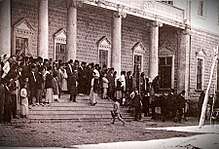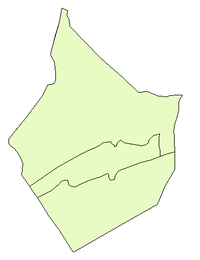Fadel Al-Aboud
| Fadel Aboud Al-Hassan فاضل عبود الحسن | |
|---|---|
 Haj Fadel Al-Aboud | |
| Born |
14 January 1872 Deir ez-Zor Ottoman Syria |
| Died |
23 December 1936 (aged 64) Deir ez-Zor Syria |
| Nationality | Syrian |
| Known for |
President of Deir ez-Zor Government, |
Fadel Aboud Al-Hassan or Haj Fadel Al-Aboud (Arabic: الحاج فاضل العبود) as was called by people of Deir al-Zour, Wajih and a Syrian leader head a government in eastern Syria (known as Haj Fadel Government) and its center in Deir al-Zour`s city after the Ottomans left the region in 1918.[1][2]
Lineage
Fadel Aboud Al-Hassan was born in Deir al-Zour in 1872 to Al-Hasan family from the clan of Abo Obaid from the Baggara tribe, which is attributed to Imam Muhammad Al-Baqir, one of the grandsons of the faithful Ali Bin Abi Talib.[3][4]
Personal life
leadership traits in Haj Fadel Aboud had been evident since his early childhood, He was successful in leadership after he received it, although he did not receive an education, He also had a prominent social status in the city of Deir al-Zour, which enabled him to take over the leadership, inherited this status from his father Aboud Hassan. Haj Fadel worked in trade and had extensive commercial relations with the Turkish merchants and Halbians and with his cousins Najjar and Tayfur in the city of Hama.
Government Formation

Formation of the first government
Chaos broke out in the city of Deir al-Zour after the Ottomans had left on November 6, 1918 due to the absence of government authority, and increased fear of the people in Deir al-Zour from the tribal environment surrounding their city, Which the clans used to invade loot and steal from each other, or enter towns and loot houses, so It was necessary to have a strong authority to protect the city and its people, which led the Haj Fadel Al-Aboud, who was the mayor to form his first government in the city and asked the clans in the villages and neighboring areas to loyal and stand with him, so all the clans were loyal to him, One of the priorities of this government was to control security in the city and this government was later known as the "Haj Fadhil government". [5][6]
The government continued until the arrival of Sharif Nasser, the cousin of Prince Faisal Bin Al-Hussein on December 1, 1918, and the arrival of Mari Basha Al-Mallah on December 7, 1918.[7]

Formation of the second government
After the events of the Battle of Maysalun on July 24, 1920 and The occupation of Damascus by the French forces, Deir al-Zour was in a state of chaos and insecurity, This is what prompted Haj Fadel Al-Aboud to form his second government, Which provided great services to the city in protecting and preserving the safety of its people despite its limited potential. Until November 23, 1920, when it was dissolved by a decision of the French occupation authorities. [8][9]
Syrian National Congress


Haj Fadel Al-Aboud represented the Euphrates region at the Syrian National Congress held in late June 1919, which proclaimed on March 8, 1920, the independence of Syria and establishment of the Syrian Arab Kingdom and inauguration of Faisal bin Sharif Hussein as its king.[10] Fadel Al-Aboud participated in the inauguration ceremony of Faisal King of Iraq on August 23, 1921, and was supporting to his inauguration.[11][12]
Armenian Genocide
The Armenians were marched out to the Syrian city of Deir al-Zour and the surrounding desert. The Ottoman government deliberately withheld the facilities and supplies that would have been necessary to sustain the life of hundreds of thousands of Armenian deportees during and after their forced march to the Syrian desert.[13][14]
Haj Fadel, who was mayor of Deir al-Zour, saved and helped them and provided them with food and housing and all means of livelihood and security, and Armenians returned the favor to Haj Fadel When he was sentenced to death by the French colonialism in Aleppo, where they supported and defended him, which made the French abolish the death sentence and exile him to Jisr Al-Shughour city. [15]
Struggle against the French mandate

Haj Fadel Al-Aboud was arrested several times for his support of national issues and revolutions, after the storming of Deir al-Zour on 9 November 1921 by the French colonialists, a group of French armored vehicles and dozens of soldiers encircled the house of Haj Fadel al-Aboud, where he was arrested and transferred to the military airport of Deir al-Zour and then transported by military aircraft to Aleppo, where he was imprisoned in the castle and met during his imprisonment with Ibrahim Hanano.
He was sentenced to exile to the city of Jisr al-Shughour after he was accused of preparing a popular revolt against French colonialism in protest against the military campaign by the French army against the Bukhabur tribes that refused to pay taxes to the French colonizer. As well as insulting Wali Deir al-Zour Khalil Isaac, who was cooperating with the French.
Protested the decision of the French High Commissioner Maurice Paul Sarai No. 49/5 August 1925 to exile his cousin and his sister's husband Ayash al-Hajj with all his family members to the Syrian city of Jableh for their struggle against French colonization, and this was the reason for his repeated arrest by French colonialism.[16][17][18][19]
Death
Haj Fadel Al-Aboud died in 1936 in the city of Deir al-Zour and was buried there. and his sons continued in the political work, His son Dr.Badri Fadel Aboud became Minister of Health in the government of Mr. Said Al-Ghazi in 1955 under the presidency of President Shukri Al-Quwatli to be the first Minister of Health from Deir al-Zour.
See also
References
- ↑ Alnajem، Ismail، "Fadel Alaboud" First Haj Fadel Government، An article published in eSyria Web site، 21/12/2013.
- ↑ Waleed، Alaa، The sons of Deir al-Zour evoke the experience of the government of Haj Fadel، An article published in orient news Web site، 09/02/2013.
- ↑ Mohammed Alayiesh، Wikipedia.
- ↑ Mohammed Alayiesh, Souriatna Journal، Second year، 7/10/2012، Issue Number: 55، Page 11.
- ↑ Bukhapur revolution with dates and evidence، Website Al-Muhasan City.. 10,05,2017 Archived 2017-05-10 at the Wayback Machine.
- ↑ Alayyash، Abdul Qader، Prepare: Walid al-Mashouh، Hadarat Wady Alfurat ،Al Ahali for printing publishing and distribution، First Edition، 1989، P 152..
- ↑ Alhaj Fadel Alaboud, An article published in Baggara tribe Web site, 30/03/2009.
- ↑ Alayyash، Abdul Qader، Prepare: Walid al-Mashouh، Hadarat Wady Alfurat ،Al Ahali for printing publishing and distribution، First Edition، 1989، P 154..
- ↑ Alshamary, Anwar, Biggest Baggara Tribe, Dar Almaref, Homs, 1996, Page: 363..
- ↑ King's Complete History of the World War, William C. King, The History Associates, 1922, page 665
- ↑ Alshamary, Anwar, Biggest Baggara Tribe, Dar Almaref, Homs, 1996, Page: 362..
- ↑ Syrian National Congress، Arabic Wikipedia.
- ↑ "Exiled Armenians starve in the desert; Turks drive them like slaves, American committee hears ;- Treatment raises death rate". The New York Times. 8 August 1916. Archived from the original on 2 February 2012. (cited by McCarthy, Justin (15 August 2010). The Turk in America: The Creation of an Enduring Prejudice. University of Utah Press. p. 177. ISBN 9781607810131. )
- ↑ Danieli, Yael (1998). International Handbook of Multigenerational Legacies of Trauma. Springer Science & Business Media. p. 23. ISBN 9780306457388.
[Victims] were often held without food for days so they would be too weak to escape
- ↑ Alshamary, Anwar, Biggest Baggara Tribe, Dar Almaref, Homs, 1996, Page: 363..
- ↑ Alnigress، Mahmoud، Bo Jimaa Bottel، Furat newspaper، 2005..
- ↑ Sabbagh, Rend, Deir al-Zour city on the banks of Paradise, Al Quds Al Arabi, Twenty-eighth year, 09/04/2017 number 8789, page 34..
- ↑ Al-Saqal, Fathallah, wholesale execution, Manarat al-Furat magazine, 09/2009, p. 29..
- ↑ Fattouh, Issa, Abdul Qader Ayyash Researcher and Historian, Almarifa Magazine, Ministry of Culture in the Syrian Arab Republic, No 646, year 56, July 2017, p 155..
